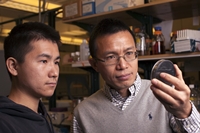Purdue scientists reveal how bacteria build homes inside healthy cells
By By Elizabeth K. Gardner | 09 Feb 2012
Bacteria are able to build camouflaged homes for themselves inside healthy cells - and cause disease - by manipulating a natural cellular process.
 |
| Purdue associate professor of biological sciences Zhao-Qing Luo, at right, and graduate student Yunhao Tan look at the growth of Legionella pneumophila bacteria in a petri dish. (Purdue University photo provided by Laurie Iten and Rodney McPhail) |
Purdue University biologists led a team that revealed how a pair of proteins from the bacteria Legionella pneumophila, which causes Legionnaires disease, alters a host protein in order to divert raw materials within the cell for use in building and disguising a large structure that houses the bacteria as it replicates.
Zhao-Qing Luo, the associate professor of biological sciences who headed the study, said the modification of the host protein creates a dam, blocking proteins that would be used as bricks in cellular construction from reaching their destination. The protein "bricks" are then diverted and incorporated into a bacterial structure called a vacuole that houses bacteria as it replicates within the cell. Because the vacuole contains materials natural to the cell, it goes unrecognised as a foreign structure.
"The bacterial proteins use the cellular membrane proteins to build their house, which is sort of like a balloon," Luo said. "It needs to stretch and grow bigger as more bacterial replication occurs. The membrane material helps the vacuole be more rubbery and stretchy, and it also camouflages the structure. The bacteria is stealing material from the cell to build their own house and then disguising it so it blends in with the neighborhood."
The method by which the bacteria achieve this theft is what was most surprising to Luo.
The bacterial proteins, named AnkX and Lem3, modify the host protein through a biochemical process called phosphorylcholination that is used by healthy cells to regulate immune response. Phosphorylcholination is known to happen in many organisms and involves adding a small chemical group, called the phosphorylcholine moiety, to a target molecule, he said.






























